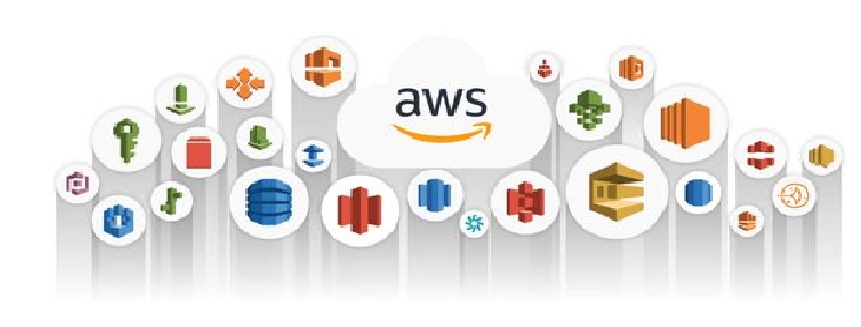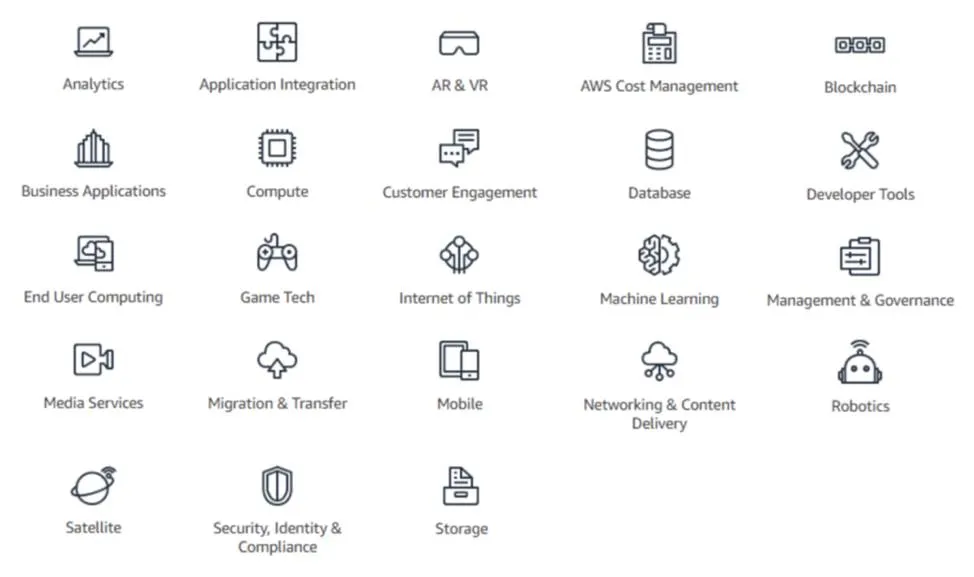Amazon Web Services

What Is AWS?¶
AWS stands for Amazon Web services. It is a secure cloud services platform provided by Amazon which offers computing, data storage, content delivery, and other functionality to help businesses scale and grow. Its easy payment method is based on pay as you go model i.e. save when your reserve, pay less by using more.
AWS is famous amongst other cloud providers since AWS is the oldest player in the cloud-computing with a plethora of services and experiences. They are equipped with the best resources and team to manage the infrastructure.
What are the different domains in AWS?¶
Some of the few domains in AWS out of many other domains, which are widely used which we will be discussing are:

Compute¶
Compute services provide you with on-demand computing services. That means you can use computing as and when required to suit any requirements. You do not have to worry about the availability of servers and how to manage them. AWS manages everything.
The compute domain is further categorized into three sub-domains including computing workloads, containers, and Kubernetes services.
The term “serverless” means that your code runs on servers, but you do not need to provision or manage these servers. With serverless computing, you can focus on innovating new products and features instead of maintaining servers.
Compute workload includes some of the following services such as:
| Service | Function |
|---|---|
| EC2 (Elastic Compute Cloud) | It offers granular control for managing your infrastructure with the choice of processors, storage, and networking. |
| Lambda | AWS Lambda is an AWS service that lets you run code without needing to manage or provision servers. While using AWS Lambda, you pay only for the compute time that you consume. Charges apply only when your code is running. You can also run code for virtually any type of application or backend service, all with zero administration. |
| Elastic Beanstalk | Easy-to-use service for deploying and scaling web applications and services |
| Amazon LightSail | Its a virtual private server for a low, predictable price, and serverless computing with AWS Lambda. Easy-to-use cloud platform that offers you everything you need to build an application or website |
| Elastic Load Balancing | It is the AWS service that automatically distributes incoming application traffic across multiple resources, such as Amazon EC2 instances. This helps to ensure that no single resource becomes overutilized. |
| Elastic Auto Scaling | Automatically add or remove compute capacity to meet changes in demand. Amazon EC2 Auto Scaling helps you maintain application availability and allows you to automatically add or remove EC2 instances according to conditions you define. |
AWS container services offer the best choice and flexibility of services to run your containers. Containers provide you with a standard way to package your application’s code and dependencies into a single object. You can also use containers for processes and workflows in which there are essential requirements for security, reliability, and scalability.
Amazon Elastic Container Service (Amazon ECS) is a highly scalable, high-performance container management system that enables you to run and scale containerized applications on AWS. Amazon ECS supports Docker containers. Docker is a software platform that enables you to build, test, and deploy applications quickly.
Amazon Elastic Kubernetes Service (Amazon EKS) is a fully managed Kubernetes service. Kubernetes is open-source software that enables you to deploy and manage containerized applications at scale.
Storage¶
The Storage domain includes services related to data storage, it includes some of the following services:
| Service | Function |
|---|---|
| S3 (Simple Storage Service) | Amazon S3 is an object storage platform that allows you to store and retrieve any amount of data, at any time, from anywhere on the web. An Amazon S3 bucket is a versatile storage option with the ability to: host a static web site, retain version information on objects, and employ life-cycle management policies to balance version retention with bucket size and cost. |
| Elastic Block Store(EBS) | It is a persistent block storage for instances, protected through replication, different drive types, scale up or down in minutes, pay for what you provision, snapshot functionality, encryption available |
| Amazon Glacier | It is used for data archiving and long term backup. It is best suited for long term storage, and infrequently accessed data. |
Database¶
The Database domain is used for database related workloads, it includes the following services: easy to set up, maintain, operate and scale a relational database in the cloud.
| Service | Function |
|---|---|
| Amazon Aurora | enterprise class relational database |
| Amazon DynamoDB | fast and flexible NoSQL database service for any scale , fully managed, low latency queries, fine grained access control, regional and global options. |
| Amazon DocumentDB | MongoDB-compatible database |
| Amazon Neptune | Graph database |
Networking and Content Delivery¶
The Networking and Content Delivery domain is used for isolating your network infrastructure, and content delivery is used for faster delivery of content. It includes the following services:
- Amazon Route 53
- AWS Direct Connect
- Amazon VPC(Virtual private cloud)- select ip4 or ip6,exists single per region.
- AWS VPN
Management Tools¶
The Management Tools domain consists of services which are used to manage other services in AWS, it includes the following services:
For Cloud monitoring, AWS has CloudWatch
For data visibility, AWS has CloudTrail
And for managing access, AWS has IAM
Security & Identity Compliance¶
The Security & Identity Compliance domain consist of services which are used to manage to authenticate and provide security to your AWS resources. It consists of the following services:
-
AWS IAM(AWS Identity and access management) assign granular permissions to users, groups, or roles; share temporary access to your AWS account; Federate users in your corporate network or with an internet identity provider.
-
AWS KMS(key management service)
-
AWS Shield - managed DDoS protection service; always on detection and mitigations; seamless integration and deployment; cost-efficient and customizable protection.
-
Amazon cognito
Messaging¶
The Messaging domain consists of services which are used for queuing, notifying or emailing messages. It consists of the following domains:
-
A**mazon Simple Queue Service (Amazon SQS)** is a service that enables you to send, store, and receive messages between software components through a queue. A user or service retrieves a message from the queue, processes it, and then deletes it from the queue.
-
Amazon Simple Notification Service (Amazon SNS) is a publish/subscribe service. Using Amazon SNS topics, a publisher publishes messages to subscribers. In Amazon SNS, subscribers can be web servers, email addresses, AWS Lambda functions, or several other options.
How to determine the right region for your services?¶
In order to determine the right region for your services,applications, and data based on these factors:
- data governance, legal requirements
- proximity to customers(latency)
- services available within the region
- costs(vary by region)
How the Pricing model works in AWS?¶
The pricing model is based on four categories:
- On-demand instances - charged per hr/sec; short-term; unpredictable workloads
- Dedicated hosts - physical server dedicated to you; applications with specific compliance requirements
- Reserved instances - discount for 1 to 3 year commitments; applications with steady state usage
- Spot instances - spare AWS capacity for up to 90% discount; applications with flexible start and end times; urgent computing needs for large amounts of capacity.